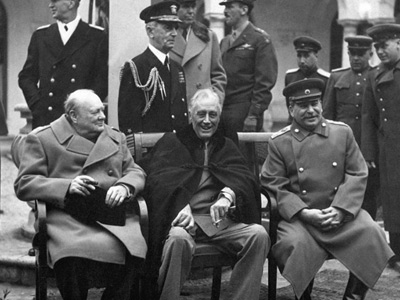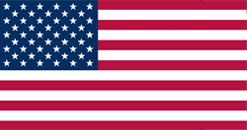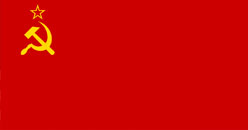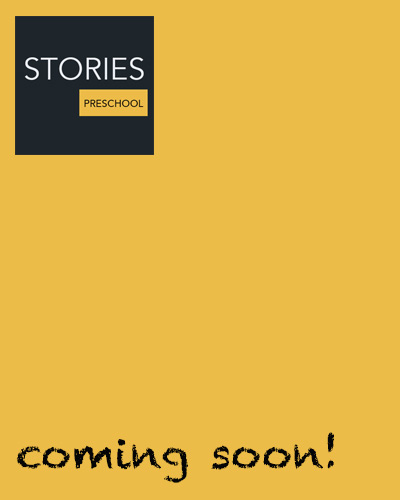Cold War (1947–1991)
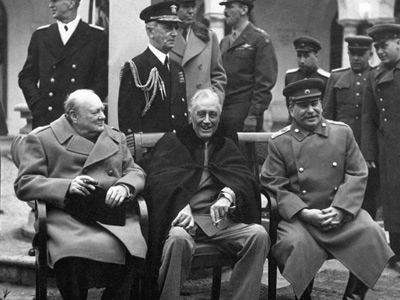
Background
Russian Revolution
While most historians trace its origins to the period immediately following World War II, others argue that it began with the October Revolution in Russia in 1917 when the Bolsheviks took power. In 1919 Lenin stated that his new state was surrounded by a "hostile capitalist encirclement", and he viewed diplomacy as a weapon that should be used in order to keep the Soviet Union's enemies divided, beginning with the establishment of the Communist International, which called for revolutionary upheavals abroad. Historian Max Beloff argues that the Soviets Soviet Union, officially the Union of Soviet Socialist Republics (USSR), was a transcontinental country that spanned much of Eurasia from 1922 to 1991. The Soviet Union fall process began with growing unrest in the Union's various constituent national republics developing into an incessant political and legislative conflict between them and the central government. Estonia was the first Soviet republic to declare state sovereignty inside the Union. saw "no prospect of permanent peace", with the 1922 Soviet Constitution proclaiming:
Soviet Union, officially the Union of Soviet Socialist Republics (USSR), was a transcontinental country that spanned much of Eurasia from 1922 to 1991. The Soviet Union fall process began with growing unrest in the Union's various constituent national republics developing into an incessant political and legislative conflict between them and the central government. Estonia was the first Soviet republic to declare state sovereignty inside the Union. saw "no prospect of permanent peace", with the 1922 Soviet Constitution proclaiming:
Since the time of the formation of the soviet republics, the states of the world have divided into two camps: the camp of capitalism and the camp of socialism. There - in the camp of capitalism - national enmity and inequality, colonial slavery, and chauvinism, national oppression and pogroms, imperialist brutalities and wars. Here - in the camp of socialism - mutual confidence and peace, national freedom and equality, a dwelling together in peace and the brotherly collaboration of peoples.
According to British historian Christopher Sutton:
In what some have called the First Cold War, from Britain’s intervention in the Russian Civil War in 1918 to its uneasy alliance with the Soviet Union against the Axis powers in 1941, British distrust of the revolutionary and regicidal Bolsheviks resulted in domestic, foreign, and colonial policies aimed at resisting the spread of communism. This conflict after 1945 took on new battlefields, new weapons, new players, and a greater intensity, but it was still fundamentally a conflict against Soviet imperialism (real and imagined).
The idea of long-term continuity is a minority scholarly view that has been challenged. Frank Ninkovich writes:
As for the two cold wars thesis, the chief problem is that the two periods are incommensurable. To be sure, they were joined together by enduring ideological hostility, but in the post-World War I years Bolshevism was not a geopolitical menace. After World War II, in contrast, the Soviet Union was a superpower that combined ideological antagonism with the kind of geopolitical threat posed by Germany and Japan in the Second World War. Even with more amicable relations in the 1920s, it is conceivable that post-1945 relations would have turned out much the same.
Beginnings of World War II
After signing the Molotov-Ribbentrop pact and German–Soviet Frontier Treaty, the Soviet Union forced the Baltic countries—Estonia, Latvia and Lithuania—to allow it to station Soviet troops in their countries under pacts of "mutual assistance". Finland rejected territorial demands, prompting a Soviet invasion in November 1939. The resulting Winter War ended in March 1940 with Finnish concessions. Britain and France France, officially the French Republic is transcontinental country predominantly located in Western Europe and spanning overseas regions and territories in the Americas and the Atlantic, Pacific and Indian Oceans. France reached its political and military zenith in the early 19th century under Napoleon Bonaparte, subjugating much of continental Europe and establishing the First French Empire. , treating the Soviet attack on Finland as tantamount to its entering the war on the side of the Germans, responded to the Soviet invasion by supporting the USSR's expulsion from the League of Nations.
France, officially the French Republic is transcontinental country predominantly located in Western Europe and spanning overseas regions and territories in the Americas and the Atlantic, Pacific and Indian Oceans. France reached its political and military zenith in the early 19th century under Napoleon Bonaparte, subjugating much of continental Europe and establishing the First French Empire. , treating the Soviet attack on Finland as tantamount to its entering the war on the side of the Germans, responded to the Soviet invasion by supporting the USSR's expulsion from the League of Nations.
In June 1940, the Soviet Union forcibly annexed Estonia, Latvia and Lithuania, and the disputed Romanian regions of Bessarabia, Northern Bukovina and Hertza. But after the German Army invaded the Soviet Union in June 1941 and the Japanese The Empire of Japan, also known as the Japanese Empire or Imperial Japan, was a historical nation-state and great power that existed from the Meiji Restoration in 1868 until the enactment of the post-World War II 1947 constitution and subsequent formation of modern Japan. Economic and political turmoil in the 1920s led to the rise of militarism, nationalism and totalitarianism eventually culminating in Japan's membership in the Axis alliance. bombed Pearl Harbor in December 1941, the Soviet Union and the Allied powers formed an alliance of convenience. Britain
The Empire of Japan, also known as the Japanese Empire or Imperial Japan, was a historical nation-state and great power that existed from the Meiji Restoration in 1868 until the enactment of the post-World War II 1947 constitution and subsequent formation of modern Japan. Economic and political turmoil in the 1920s led to the rise of militarism, nationalism and totalitarianism eventually culminating in Japan's membership in the Axis alliance. bombed Pearl Harbor in December 1941, the Soviet Union and the Allied powers formed an alliance of convenience. Britain The United Kingdom of Great Britain and Northern Ireland, commonly known as the United Kingdom (UK) or Britain, is a country in Europe, off the north-western coast of the continental mainland. It comprises England, Scotland, Wales and Northern Ireland. The UK became the world's first industrialised country and was the world's foremost power during the 19th and early 20th centuries. signed a formal alliance and the United States
The United Kingdom of Great Britain and Northern Ireland, commonly known as the United Kingdom (UK) or Britain, is a country in Europe, off the north-western coast of the continental mainland. It comprises England, Scotland, Wales and Northern Ireland. The UK became the world's first industrialised country and was the world's foremost power during the 19th and early 20th centuries. signed a formal alliance and the United States The United States of America (U.S.A. or USA), commonly known as the United States (U.S. or US) or America, is a country in North America. It is the world's third-largest country by both land and total area. The United States shares land borders with Canada to its north and with Mexico to its south. The national capital is Washington, D.C., and the most populous city and financial center is New York City. made an informal agreement. In wartime, the United States supplied Britain, the Soviet Union and other Allied nations through its Lend-Lease Program. However, Stalin remained highly suspicious and he believed that the British and the Americans had conspired to ensure that the Soviets bore the brunt of the fighting against Nazi Germany. According to this view, the Western Allies had deliberately delayed opening a second anti-German front in order to step in at the last minute and shape the peace settlement. Thus, Soviet perceptions of the West left a strong undercurrent of tension and hostility between the Allied powers.
The United States of America (U.S.A. or USA), commonly known as the United States (U.S. or US) or America, is a country in North America. It is the world's third-largest country by both land and total area. The United States shares land borders with Canada to its north and with Mexico to its south. The national capital is Washington, D.C., and the most populous city and financial center is New York City. made an informal agreement. In wartime, the United States supplied Britain, the Soviet Union and other Allied nations through its Lend-Lease Program. However, Stalin remained highly suspicious and he believed that the British and the Americans had conspired to ensure that the Soviets bore the brunt of the fighting against Nazi Germany. According to this view, the Western Allies had deliberately delayed opening a second anti-German front in order to step in at the last minute and shape the peace settlement. Thus, Soviet perceptions of the West left a strong undercurrent of tension and hostility between the Allied powers.
HISTORY
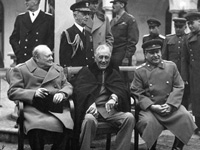
RESOURCES
This article uses material from the Wikipedia article "Cold War (1947–1991)", which is released under the Creative Commons Attribution-Share-Alike License 3.0.
© Stories Preschool. All Rights Reserved.
